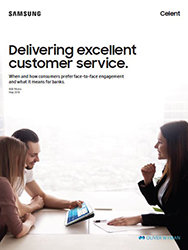The ability to successfully engage with the increased pace of innovation is a defining characteristic of today’s best CIOs. Some 9,000 senior IT leaders met in Orlando this month for the Gartner ITxPO, a symposium focused on strategic digital transformation. In a keynote, Gartner EVP Mike Harris provided a simple formula for an audience of CIOs grappling with continuous adaptation in the enterprise:
(Mindsets + Practices) x Technology = Capabilities
You can’t simply add new technology to the equation and expect new capabilities to emerge. Chances are, you’ll encounter some human resistance. Instead, by changing practices and mindsets along with your technology, you can change results entirely.
The Gartner Symposium began with industry-focused sessions, where I was able to share my talk on “Transforming the Banking Workplace and the Mobile-First Customer Experience.” Finance CIOs are spending more on mobile and digital than branch technology, but their greatest opportunities for customer engagement are in the branch. Seventy-seven percent of banking customers prefer in-branch engagement.
During his session, titled “A View Over the Digital Banking Horizon: Scenarios for You and Your Industry,” Gartner Vice President of Research Alistair Newton spoke about the four fundamentally disruptive technology trends, including IoT, Artificial Intelligence, Platforms and Open Banking, and Blockchain.
While the four trends were separate on their own, they did have a common thread: what value can banks create in the future, and how will these digital disruptions empower that movement?
In working with some of the largest financial institutions in the U.S., I’ve learned that there are three common characteristics of institutions who achieve remarkable results in branch innovation.
Move quickly
Get started with practical innovation and prioritize going live with new technology as quickly as possible. Financial institutions typically have one or more innovation labs for testing and incubating new technology and piloting it among test groups of retail banking customers. Innovators test until a technology is perfected before a vision is launched, and these labs don’t always move as fast as the speed of compliance changes. Sometimes, technology as a whole has entirely changed before a lab project is complete.
Create Personalized Customer Experiences in the Branch
Get your free guide to when, how and why consumers want face-to-face interaction with their banks. Download Now
Remarkable things can happen when you go live and launch your vision in small increments in your retail bank branches. You can discover new use cases with added value. At Samsung, we’ve mastered what we call “iterative innovation,” and we’ve passed this vision onto our clients. Instead of tackling total mobile transformation in the bank branch, banks can go live quickly with the new Galaxy Tab S4 tablets to replace desktop computing.
Move with speed
Speed is a competitive advantage in customer service and the operations of your bank branch. In finance and all other industries, Gartner research has found that “dynamism” or ability to embrace and adopt new technologies is the single strongest predictor of success.
To go live quickly, avoid mobile branch solutions that require complex integration or sensitive customer data. The Samsung Galaxy Watch is built for moving at speed. It can notify bankers when teammates or customers need assistance. The most effective banks structure future pilots in a way that prioritizes speed, such as going live immediately on LTE devices.
Move collaboratively
There’s a common misconception that a closely-guarded technology vision is a competitive advantage. However, secrecy is the opposite of effective innovation. Some of the most effective visionaries I’ve worked with in finance are highly effective collaborators who are willing to explore open-source and collaborative solutions for better customer engagement in the branch.
“Leaders should hire for curiosity [and] model inquisitiveness … doing so will help their organizations adapt to uncertain market conditions,” stated a recent Harvard Business Review article, “The Business Case for Curiosity.” Curiosity and a willingness to explore new methods of innovation could lead to new solutions in finance. Transform your branch experience using technology that can go live in the next 6-12 months and create new models for collaboration. The next disruptive solution for finance could come from another industry entirely.
The mobile-first retail banking branch
We openly share our mobile-first bank vision at Samsung — a fully interactive customer experience that caters to the mobile customer. Beacon technology provides a personalized, frictionless customer check-in, while Samsung DeX and Galaxy tablets enable retail banking associates to seamlessly interact with customers across the mobile branch. The result is a personalized, efficient end-to-end experience backed by a secure VDI, which shifts the role of the branch from transactional to consultative.
Near-term iteration is key to delivering on retail banking customers’ growing expectations. Financial institutions must prioritize motion, and prioritize going live with mobile technologies to enable new operating models. If your vision is held too closely by the innovation lab, you may miss opportunities for customer engagement use cases or get left behind by the speed of technological change. Applied innovation requires moving quickly, and being open to new possibilities which emerge from many different sources.
Kick off your mobile transformation with Samsung’s secure, innovative financial technology solutions, or learn exactly what consumers are looking for when they arrive to the bank branch — and how mobile-equipped associates can help.









